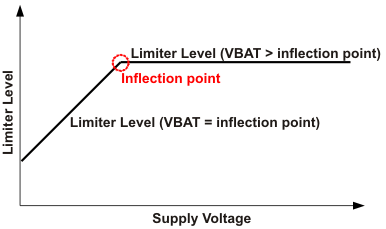SLOS638C November 2011 – June 2022 TPA2015D1
PRODUCTION DATA
- 1 Features
- 2 Applications
- 3 Description
- 4 Revision History
- 5 Device Comparison Table
- 6 Pin Configuration and Functions
- 7 Specifications
- 8 Parameter Measurement Information
-
9 Detailed Description
- 9.1 Overview
- 9.2 Functional Block Diagram
- 9.3 Feature Description
- 9.4 Device Functional Modes
- 10Application and Implementation
- 11Power Supply Recommendations
- 12Layout
- 13Device and Documentation Support
- 14Mechanical, Packaging, and Orderable Information
Package Options
Mechanical Data (Package|Pins)
- YZH|16
Thermal pad, mechanical data (Package|Pins)
Orderable Information
9.3.1.2 Battery Tracking SpeakerGuard™
The TPA2015D1 monitors the battery voltage and the audio signal, automatically decreasing gain when battery voltage is low and audio output power is high. It finds the optimal gain to maximize loudness and minimize battery current, providing louder audio and preventing early shutdown at end-of-charge battery voltages. SpeakerGuard™ decreases amplifier gain when the audio signal exceeds the limiter level. The limiter level automatically decreases when the supply voltage (VBAT) is below the inflection point. Figure 9-3 shows a plot of the limiter level as a function of the supply voltage.
 Figure 9-3 Limiter Level vs Supply Voltage
Figure 9-3 Limiter Level vs Supply VoltageThe limiter level decreases within 60 µs of the supply voltage dropping below the inflection point. Although this is slightly slower than the 26 µs/dB SpeakerGuard™ attack time, the difference is audibly imperceptible.
Connect a resistor between the AGC pin and ground to set the inflection point, as shown in Table 9-1. Leave the AGC pin floating to disable the inflection point, keeping the limiter level constant over all supply voltages.
The maximum limiter level is fixed, as is the slope of the limiter level versus supply voltage. If different values for maximum limiter level and slope are required, contact your local Texas Instruments representative.
| FUNCTION | RESISTOR ON AGC PIN | INFLECTION POINT |
|---|---|---|
| Constant limiter level; battery track OFF | Floating or connected to VBAT | disabled |
| AGC battery track option 1 | 39 kΩ | 3.55 V |
| AGC battery track option 2 | 27 kΩ | 3.78 V |
| AGC battery track option 3 | 18 kΩ | 3.96 V |
The audio signal is not affected by the SpeakerGuard™ function unless the peak audio output voltage exceeds the limiter level. Figure 9-7 shows the relationship between the audio signal, the limiter level, the supply voltage, and the supply current.
When VBAT is greater than the inflection point, the limiter level allows the output signal to slightly clip to roughly 6% THD at 2 W into 8 Ω. This is an acceptable peak distortion level for most small-sized portable speakers, while ensuring maximum loudness from the speaker.